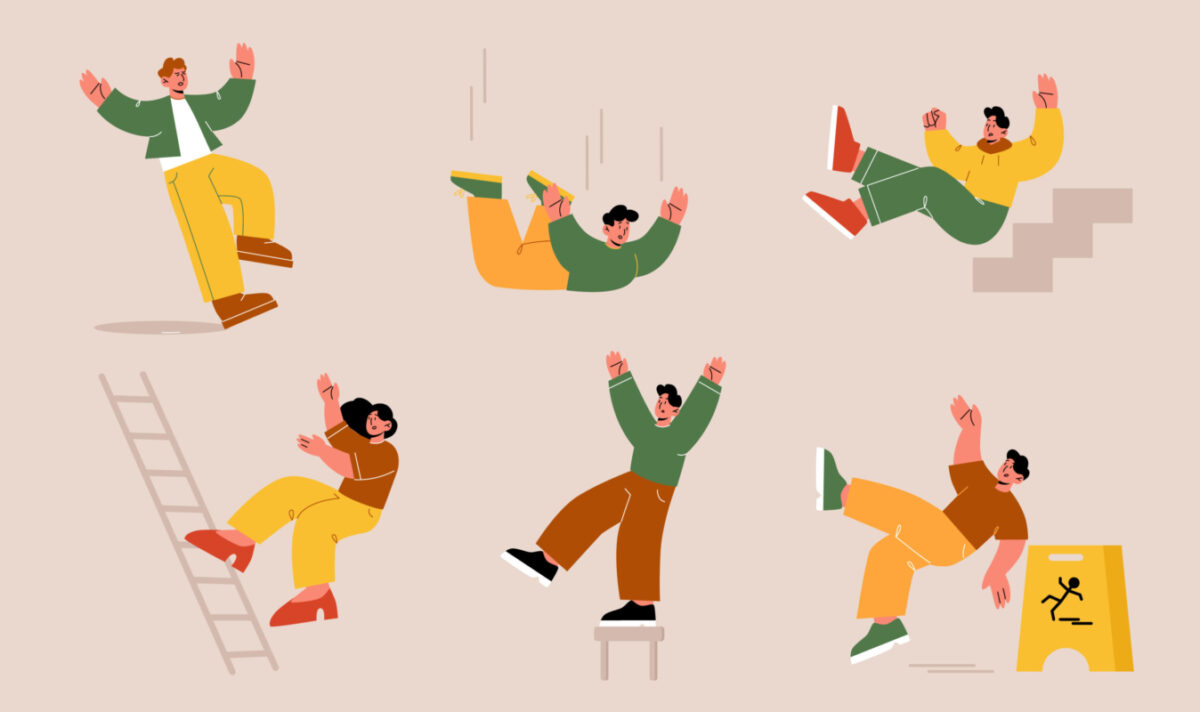What are the Risks of Falling from a Height on a Construction Site

Working at height is an everyday activity in most occupational sectors; construction work sites are no exception.
Businesses and their employers must be fully health and safety risks associated with the work operations—several occupational hazards related to working at height result in potential fatalities or serious injuries.
Understanding the dangers associated with working at height is essential to ensure worker safety and prevent accidents and ill health occurrences. This content piece, therefore, will walk readers through some common health risks linked to height work and preventive approaches to minimize them.
Statistics & Prevalence
Falls from height are common issues seen in most working environments that may expose workers to elevated risks leading them to life-long ailments, disabilities, or even fatalities in severe cases.
Studies show that fall accidents account for many injuries and fatalities in the UK alone. There are reportedly 61,000 injuries in the construction sector every year. This figure shows how serious the problem is and can result in severe consequences for businesses, both legally and financially.
These statistics emphasize the need to address fall-related dangers and require everyone to be aware of fall protection measures to avoid health hazards.
Factors Contributing to Falls at Work
The following factors play a crucial role in falling from height:
1. Exposed Edges & Openings
While working at height, keeping an eye on unguarded openings or unprotected edges is essential. Accidental falls are more likely to occur on work sites without adequate guardrails or barriers around edges and openings. Therefore, it is crucial to be vigilant when working under such circumstances.
2. Inadequate Fall Protection Systems
Fall hazards are more likely to occur when workplaces lack inadequate fall protection measures. These unsafe work systems may expose workers to inappropriate guardrails, safety nets, or a lack of personal protective equipment (PPE). Besides this, workers are also vulnerable to falls from heights when safety harnesses, lifelines, and safety nets are improper for use or are not sufficient enough to work.
These unfair work practices lead employers to compromise the health and safety of their staff and can also impose legal actions on businesses.
3. Improper Training, Guidance & Supervision
Sufficient training, guidance, and supervision are significant factors leading to fall accidents and ill health scenarios. For this purpose, employers need to consider their staff training needs. They can arrange regular online and on-site training sessions; some common ones include; a harness inspection course, a working at height course, a ladder inspection course, ladder safety training, and other similar training sessions.
4. Improper Equipment Maintenance & Scaffoldings
Inadequately maintained equipment, such as broken ladders, damaged scaffolding, or defective safety harnesses, are also prominent causes of fall hazards. Equipment and scaffoldings become unstable and out of order when not adequately maintained. When used for work, this malfunctioned equipment can result in various accidents.
5. Environmental Risks (such as slick surfaces and garbage)
Unstable weather conditions, slippery surfaces, dust, or debris are typical examples of hazardous environmental circumstances leading to an increased risk of falls.
Common Types of Risks/Injuries Associated with Height Work
Alongside the risk factors, some common health risks include:
1. Head Injuries
Falls from height can result in severe head injuries. These injuries may vary from skull fractures to paralysis. These ill health cases can cause memory loss, long-term cognitive problems, lifelong disabilities or death.
To avoid such unpleasant incidents or long-term repercussions of such accidents, employers must have necessary arrangements and safe systems of work to prevent the health and safety of their staff and workers.
2. Spinal Cord Injuries or Paralysis
Spinal cord injuries are also among the most dangerous damages resulting from accidental falls from height. If they become severe, these injuries can also lead to partial or total paralysis. Those suffering from such injuries require immediate assistance with specialized medical treatments.
3. Broken Bones or Fractures
Broken arms, legs, hips, and ribs are just a few of the many bone fracture examples that can result from falls from heights. These injuries can lead to chronic ailments that result in taking several days off work.
These injuries can cause significant problems for business owners or supervisors regarding legal and financial claims or hiring a new replacement for the injured workforce.
4. Internal Injuries or Organ Damage
Falls from a height might also impact the internal organs causing injuries, internal bleeding. or organ rupture. These injuries may also cause damage to essential organs like the liver, lungs, or kidneys. These internal injuries may prove to be fatal and, therefore, require prompt medical attention.
5. Soft Tissue Injuries
Soft tissue injuries, such as sprains and strains, are common injuries caused by fall accidents. These injuries can cause discomfort, bruising, stretched or torn muscles, tendons, or ligaments. Recovery from soft tissue injuries often requires appropriate rest, physical therapy, and rehabilitation.
Economic and Health Effects
Fall hazards can significantly impact the physical and psychological well-being of those injured.
These injuries can result in post-traumatic stress disorder or PTSD that, if not treated on time, can lead to anxiety or depression disorders.
Besides mental health concerns, these injuries can also potentially cause chronic pain and long-term disability, making it difficult for the victim to carry out everyday tasks and work, lowering the quality of life.
Financial repercussions are also one major threat to businesses. The cost of medical care, emergency care, operations, hospitalization, or rehabilitation can be challenging for the injured person and their families, so companies have a legal duty to take care of such expenses as well.
Preventive Measures
Below are some preventive measures to look for:
- Reducing the risk of falls from heights on construction sites requires implementing comprehensive fall protection measures, such as guardrails, safety nets, and personal protective equipment (PPE).
- By ensuring the dependability, stability, and functionality of equipment and buildings through routine inspection and maintenance, accidents caused by defective equipment are less likely to occur.
- Giving employees the necessary instruction and training about fall prevention methods, safety procedures, and how to use equipment safely improves their awareness of the situation and their capacity to work safely at heights.
- Good communication and oversight between workers, managers, and supervisors support a secure workplace by enabling prompt detection and remediation of possible hazards.
- Thorough risk assessments and safety planning allow for proactive risk identification and mitigation, ensuring the necessary safeguards are in place.
Conclusion
Falls from height are among the top health and safety risks causing severe injuries, damages, or fatalities at work. While talking about construction work sites, these injuries can cause several injuries.
To reduce the hazards connected with falls, employers must have proactive safety measures to implement adequate fall protection systems. Besides this, it requires the mutual effort of both employers and employees to ensure workplace safety.











Responses